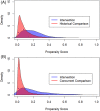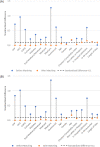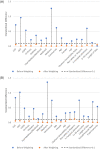Identifying appropriate comparison groups for health system interventions in the COVID-19 era
- PMID: 36247204
- PMCID: PMC9539400
- DOI: 10.1002/lrh2.10344
Identifying appropriate comparison groups for health system interventions in the COVID-19 era
Abstract
Introduction: COVID-19 has created additional challenges for the analysis of non-randomized interventions in health system settings. Our objective is to evaluate these challenges and identify lessons learned from the analysis of a medically tailored meals (MTM) intervention at Kaiser Permanente Northwest (KPNW) that began in April 2020.
Methods: We identified both a historical and concurrent comparison group. The historical comparison group included patients living in the same area as the MTM recipients prior to COVID-19. The concurrent comparison group included patients admitted to contracted non-KPNW hospitals or admitted to a KPNW facility and living outside the service area for the intervention but otherwise eligible. We used two alternative propensity score methods in response to the loss of sample size with exact matching to evaluate the intervention.
Results: We identified 452 patients who received the intervention, 3873 patients in the historical comparison group, and 5333 in the concurrent comparison group. We were able to mostly achieve balance on observable characteristics for the intervention and the two comparison groups.
Conclusions: Lessons learned included: (a) The use of two different comparison groups helped to triangulate results; (b) the meaning of utilization measures changed pre- and post-COVID-19; and (c) that balance on observable characteristics can be achieved, especially when the comparison groups are meaningfully larger than the intervention group. These findings may inform the design for future evaluations of interventions during COVID-19.
Keywords: COVID‐19; comparison groups; observational studies; program evaluation.
© 2022 The Authors. Learning Health Systems published by Wiley Periodicals LLC on behalf of University of Michigan.
Conflict of interest statement
The authors declare no potential conflict of interest.
Figures



References
-
- Rubin DB. Estimating causal effects of treatments in randomized and nonrandomized studies. J Educ Psychol. 1974;66:688‐701.
-
- Grimes DA, Schulz KF. Bias and causal associations in observational research. The Lancet. 2002;359:248‐252. - PubMed
LinkOut - more resources
Full Text Sources
Miscellaneous

